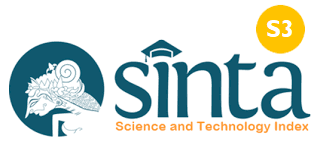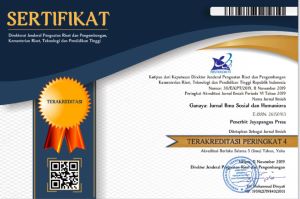Masyarakat Adat Dayak dan Penanggulangan Transboundary Haze Pollution di Kalimantan Barat
DOI:
https://doi.org/10.37329/ganaya.v6i3.2621Keywords:
Borders, Transboundary Haze Pollution, Indigenous People, Dayak People, West BorneoAbstract
This research will explore the role and involvement of the indigenous people, the Dayak Tribe, in resolving the problem of wildfire and transboundary haze pollution. This article's case study will focus on Kapuas Hulu, Kalimantan Barat. The research aims to explain indigenous people's participation in resolving transboundary haze pollution in West Borneo. This article will use qualitative methods and a descriptive approach. Data collection and analysis will be done through 1) observation to map the actors involved in resolving transboundary haze pollution, 2) interviews with actors affected by transboundary haze pollution, and 3) assessment to clarify data and secondary sources from the government. The research concludes that the involvement of the Dayak People as an indigenous tribe in West Kalimantan is relatively minimum in solving the transboundary haze pollution. Government programs focusing on transboundary haze pollution should engage with Indigenous tribes actively and deliberately.
References
Alam, S., Nurhidayah, L., & Lim, M. (2022). Towards a Transnational Approach to Transboundary Haze Pollution: Governing Traditional Farming in Fire-Prone Regions of Indonesia. Transnational Environmental Law, 1-27.
Armatas, C. A., Venn, T. J., McBride, B. B., Watson, A. E., & Carver, S. J. (2016). Opportunities to utilize traditional phenological knowledge to support adaptive management of social-ecological systems vulnerable to changes in climate and fire regimes. Ecology and Society, 21(1).
Astuty, T. I., & Hizbaron, D. R. (2017). Kearifan Lokal Masyarakat Dalam Menjaga Kelestarian Hutan dan Mengelola Mataair di Desa Beji, Kecamatan Ngawen. Jurnal Bumi Indonesia, 6(1).
Atkinson, C. L. (2014). Deforestation and transboundary haze in Indonesia: Path dependence and elite influences. Environment and urbanization Asia, 5(2), 253-267.
Cajete, G., Nelson, M. K., & Shilling, D. (2018). Native science and sustaining Indigenous communities. Traditional ecological knowledge: Learning from Indigenous practices for environmental sustainability, 15-26.
Convention C169 - Indigenous and Tribal Peoples Convention, 1989 (No. 169). (1989). Retrieved May 23, 2021, from International Labour Organization website: https://www.ilo.org/dyn/normlex/en/f?p=NORMLEXPUB:12100:0::NO::P12100_ILO_CO DE:C169
Deur, D., Recalma-Clutesi, K., & Dick, C. A. (2020). Balance on every ledger: Kwakwaka’wakw resource values and traditional ecological management. In The Routledge Handbook of Indigenous Environmental Knowledge (pp. 126-135). Routledge.
Edington, J. (2017). Indigenous Environmental Knowledge: Reappraisal. Springer.
Fernández‐Llamazares, Á., Garteizgogeascoa, M., Basu, N., Brondizio, E. S., Cabeza, M., Martínez‐Alier, J., ... & Reyes‐García, V. (2020). A state‐of‐the‐art review of indigenous peoples and environmental pollution. Integrated Environmental Assessment and Management, 16(3), 324-341.
Huruta, A. D., & Kurniasari, M. D. (2018). Environmental management within the indigenous perspective Pengelolaan lingkungan dalam perspektif penduduk asli. Masyarakat, Kebudayaan dan Politik, 31(3), 270-277.
Kementerian Lingkungan Hidup dan Kehutanan. (2021). Rekapitulasi Luas Kebakaran Hutan dan Lahan (Ha) Per Provinsi Di Indonesia Tahun 2016-2021. Diambil kembali dari SiPongi.menlhk: http://sipongi.menlhk.go.id/hotspot/luas_kebakaran
Kementerian Lingkungan Hidup dan Kehutanan. (n.d.). Indonesia National Carbon Accounting System: Kalimantan Barat. Retrieved from INCAS: http://incas.menlhk.go.id/id/data/west- kalimantan/
Khakim, A. (2005). Pengantar Hukum Kehutanan Indonesia (Dalam Era Otonomi Daerah. Bandung: PT. Citra Aditya Bakti.
Khakim, A. (2005). Pengantar Hukum Kehutanan Indonesia: Dalam Era Otonomi Daerah. Bandung: PT.Citra Aditya Bakti.
Martello, M. L. (2008). Arctic indigenous peoples as representations and representatives of climate change. Social Studies of Science, 38(3), 351-376.
Moryanti, R. (2016). Bambi Ari’ Sebagai Wujud Kearifan Lokal Masyarakat Dayak Dalam Penanganan Bencana Kabut Asap Di Kabupaten Kapuas Hulu, Kalimantan Barat. Sosiologi Reflektif, 21-39.
Muharrami, N. (2021, Februari 24). Kalbar Dapat Predikat Terbaik Tangani Karhutla. Diambil kembali dari Pemerintah Provinsi Kalimantan Barat: https://kalbarprov.go.id/berita/kalbar-dapat-predikat-terbaik-tangani-karhutla.html
Mulyoutami, E., Rismawan, R., & Joshi, L. (2009). Local knowledge and management of simpukng (forest gardens) among the Dayak people in East Kalimantan, Indonesia. Forest Ecology and Management, 2054–2061.
Nuttall, M. (2005). Protecting the Arctic: Indigenous peoples and cultural survival. New York: Routledge.
Selin, H., & Selin, N. E. (2008). Indigenous peoples in international environmental cooperation: Arctic management of hazardous substances. Review of European Community & International Environmental Law, 17(1), 72-83.
Sillitoe, P. (2020). Soil ethnoecology. In The Routledge Handbook of Indigenous Environmental Knowledge (pp. 72-94). Routledge.
Suratmo, F. G. (1995). Analisis Mengenai Dampak Lingkungan: F Gunarwan Suratmo. Gajah Mada University Press.
Tania Murray, L. (2000). Locating Indigenous Environmental Knowledge in Indonesia. In Ch. 13 Indigenous Enviromental Knowledge and Its Transformations: Critical Anthropological Perspectives (pp. 121–150). Amsterdam: Harwood Academic.
Tsosie, R. (2018). Indigenous Peoples and ‘Cultural Sustainability’: The Role of Law and Traditional Knowledge. Traditional Ecological Knowledge: Learning from Indigenous Practices for Environmental Sustainability, 1, 229-249.
Whyte, K. (2018). What Do Indigenous Knowledges Do for Indigenous Peoples? Traditional ecological knowledge: Learning from Indigenous practices for environmental sustainability, 57-81.
Williams, J. (2012). The impact of climate change on indigenous people–the implications for the cultural, spiritual, economic and legal rights of indigenous people. The International Journal of Human Rights, 16(4), 648-688.
World Bank. (2016). The Cost of FIre: an Economic Analysis of Indonesia's 2015 Fire Crisis. Jakarta: World Bank Group.
Ytterstad, A. (2020). Indigenous good sense on climate change. In Indigenous Knowledges and the Sustainable Development Agenda (pp. 150-166). Routledge.
Zhang, J. J., & Savage, V. R. (2019). Southeast Asia's transboundary haze pollution: Unravelling the inconvenient truth. Asia Pacific Viewpoint, 60(3), 355-369.
Downloads
Published
How to Cite
Issue
Section
License
Copyright (c) 2023 Adhi Cahya Fahadayna, Reza Triarda, Jovanka Mayank Candri (Author)

This work is licensed under a Creative Commons Attribution-ShareAlike 4.0 International License.
An author who publishes in the Ganaya : Jurnal Ilmu Sosial dan Humaniora agrees to the following terms:
- Author retains the copyright and grants the journal the right of first publication of the work simultaneously licensed under the Creative Commons Attribution-ShareAlike 4.0 License that allows others to share the work with an acknowledgement of the work's authorship and initial publication in this journal
- Author is able to enter into separate, additional contractual arrangements for the non-exclusive distribution of the journal's published version of the work (e.g., post it to an institutional repository or publish it in a book) with the acknowledgement of its initial publication in this journal.
- Author is permitted and encouraged to post his/her work online (e.g., in institutional repositories or on their website) prior to and during the submission process, as it can lead to productive exchanges, as well as earlier and greater citation of the published work (See The Effect of Open Access).
Read more about the Creative Commons Attribution-ShareAlike 4.0 Licence here: https://creativecommons.org/licenses/by-sa/4.0/.








